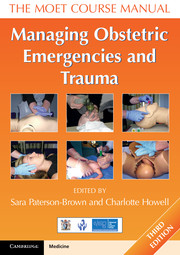Book contents
- Frontmatter
- Dedication
- Contents
- Working Group
- About the authors
- Acknowledgements
- Abbreviations
- Section 1 Introduction
- Section 2 Recognition
- Section 3 Resuscitation
- 8 Airway management and ventilation
- 9 Cardiopulmonary resuscitation in the nonpregnant and pregnant patient
- 10 Amniotic fluid embolism
- 11 Pulmonary thromboembolism
- 12 Resuscitation of the baby at birth
- Section 4 Trauma
- Section 5 Other medical and surgical emergencies
- Section 6 Obstetric emergencies
- Section 7 Triage and transfer
- Section 8 Human issues
- Index
11 - Pulmonary thromboembolism
- Frontmatter
- Dedication
- Contents
- Working Group
- About the authors
- Acknowledgements
- Abbreviations
- Section 1 Introduction
- Section 2 Recognition
- Section 3 Resuscitation
- 8 Airway management and ventilation
- 9 Cardiopulmonary resuscitation in the nonpregnant and pregnant patient
- 10 Amniotic fluid embolism
- 11 Pulmonary thromboembolism
- 12 Resuscitation of the baby at birth
- Section 4 Trauma
- Section 5 Other medical and surgical emergencies
- Section 6 Obstetric emergencies
- Section 7 Triage and transfer
- Section 8 Human issues
- Index
Summary
Objectives
On successfully completing this topic, you will be able to:
recognise the risk factors for thromboembolism and understand the need for appropriate risk assessment and thromboprophylaxis
recognise the features of pulmonary embolism and have an early suspicion of the diagnosis
describe the treatment of suspected pulmonary embolism, including massive, life-threatening pulmonary embolism.
Introduction and incidence
The risk of venous thromboembolism (VTE) is significantly increased in pregnancy overall, due to a variety of important changes in the coagulation and vascular systems. There may also be a variety of other factors that can contribute to an individual's risk.
Thrombosis and thromboembolism have been the leading cause of direct maternal deaths from 1985 to 2005. By contrast, the 2006–08 Confidential Enquiry into Maternal Deaths (Saving Mothers' Lives) reports 18 deaths from thrombosis and thromboembolism, a maternal mortality rate of 0.79/100 000 maternities, a significant decrease from the 41 deaths reported in the previous triennium and, in fact, the lowest incidence since 1985. For the first time, genital tract sepsis was the leading cause, with deaths from pre-eclampsia/eclampsia ranked second. Sixteen of the 18 deaths were attributed to pulmonary embolism and the other two to cerebral vein thrombosis. In addition, there were four late deaths attributed to pulmonary embolism.
The incidence of antenatal pulmonary embolism in the UK has recently been estimated in a prospective case–control study by UKOSS (the UK Obstetric Surveillance System) at 1.3/10 000 maternities, with a case fatality rate of 3.5% and significant severe morbidity. There were 143 women with antenatal pulmonary embolisms in the study.
- Type
- Chapter
- Information
- Managing Obstetric Emergencies and TraumaThe MOET Course Manual, pp. 129 - 138Publisher: Cambridge University PressPrint publication year: 2014

